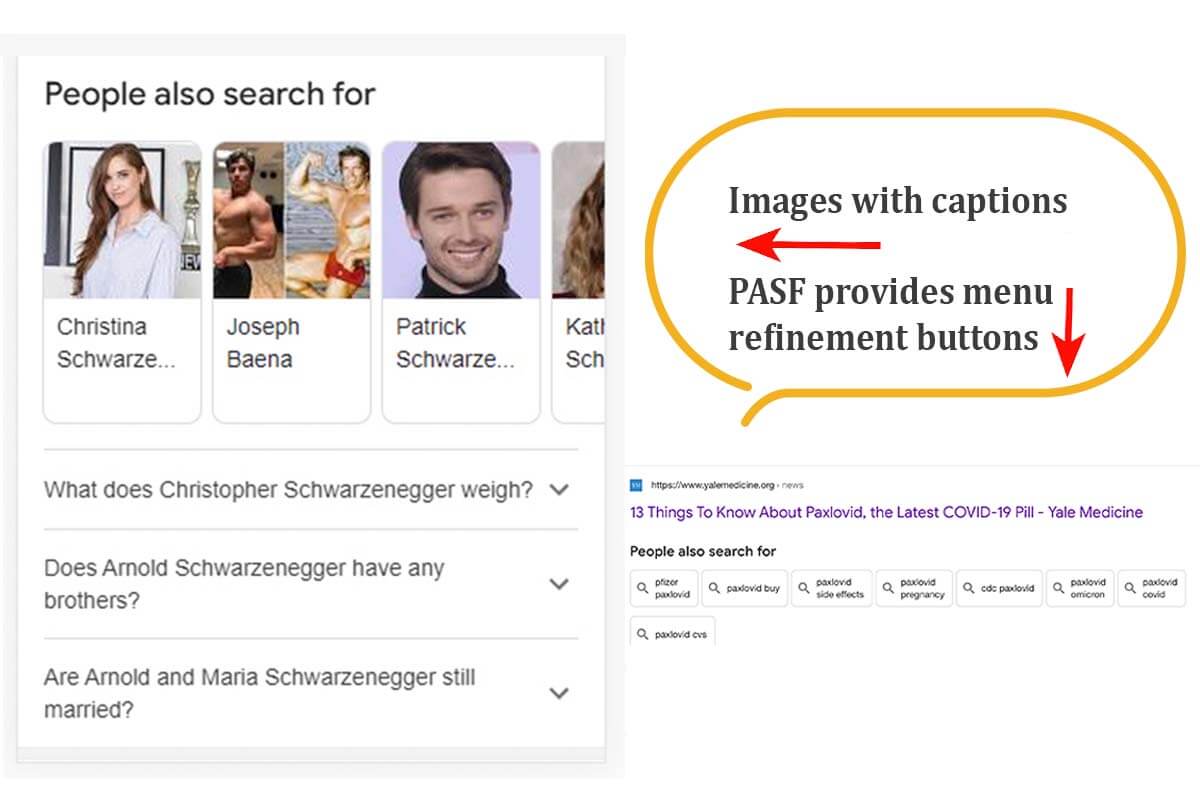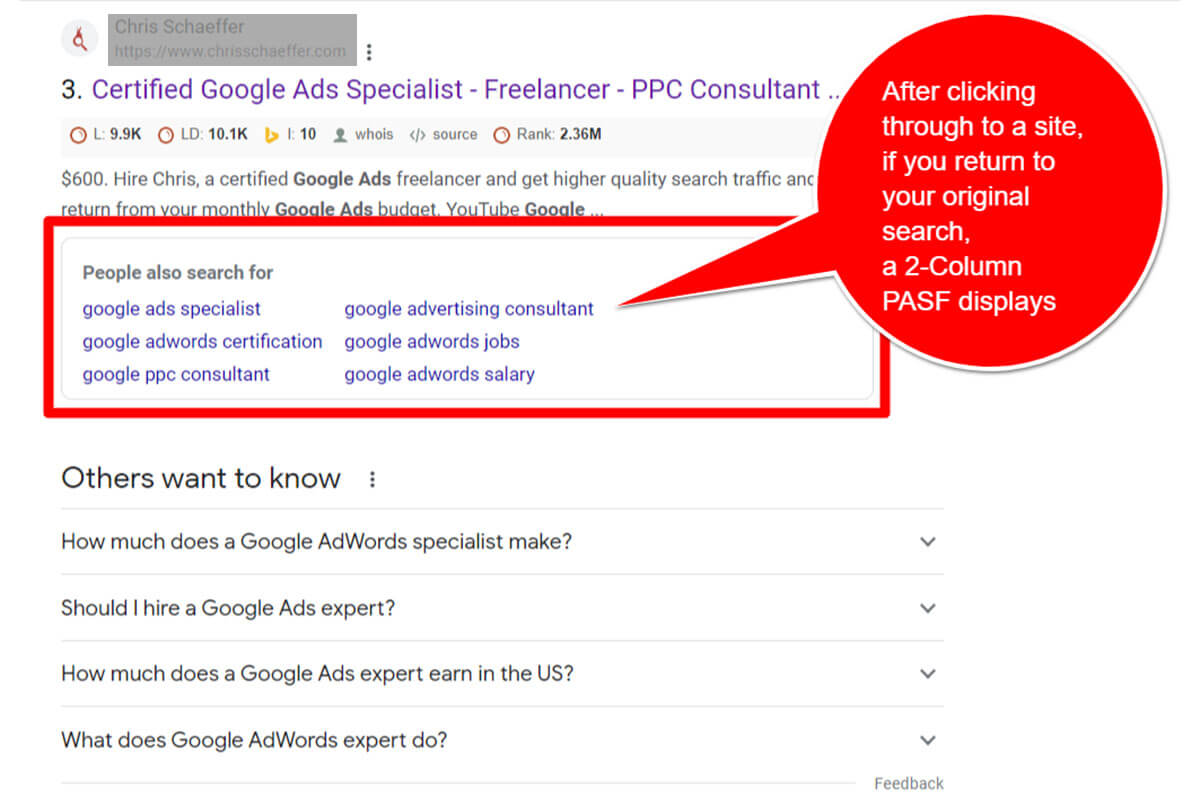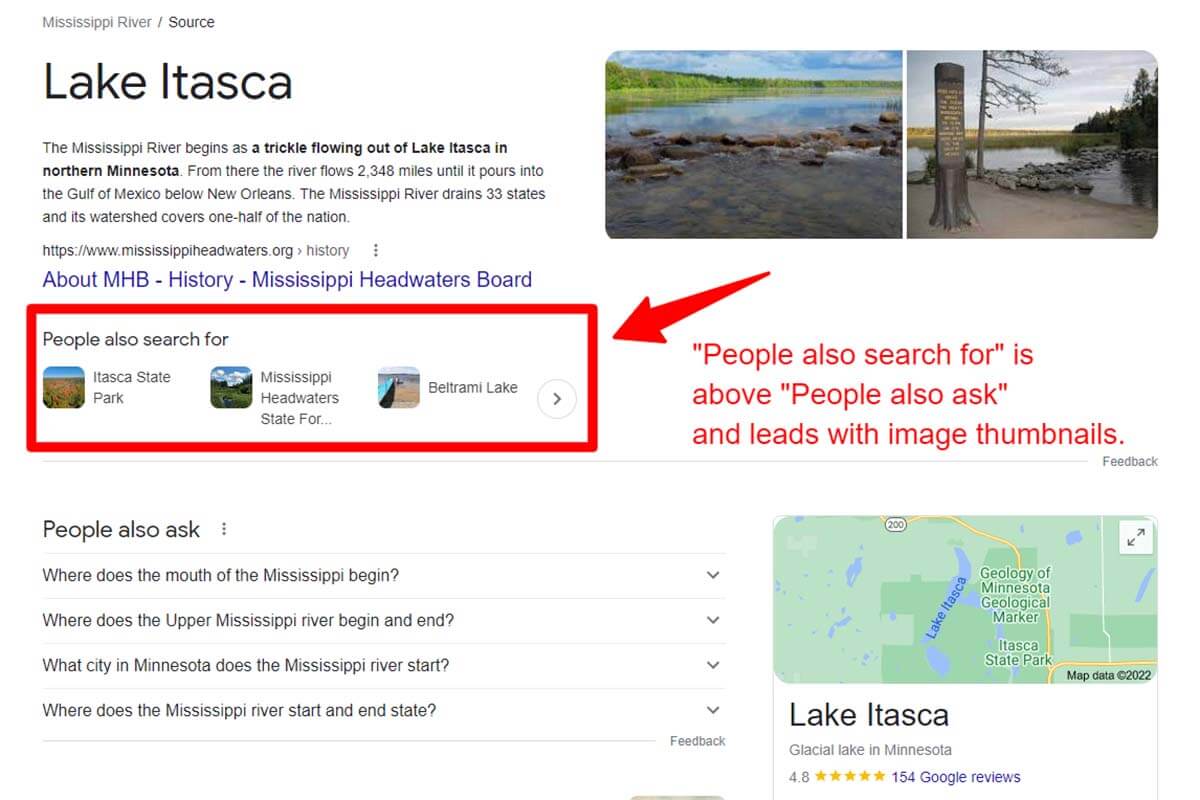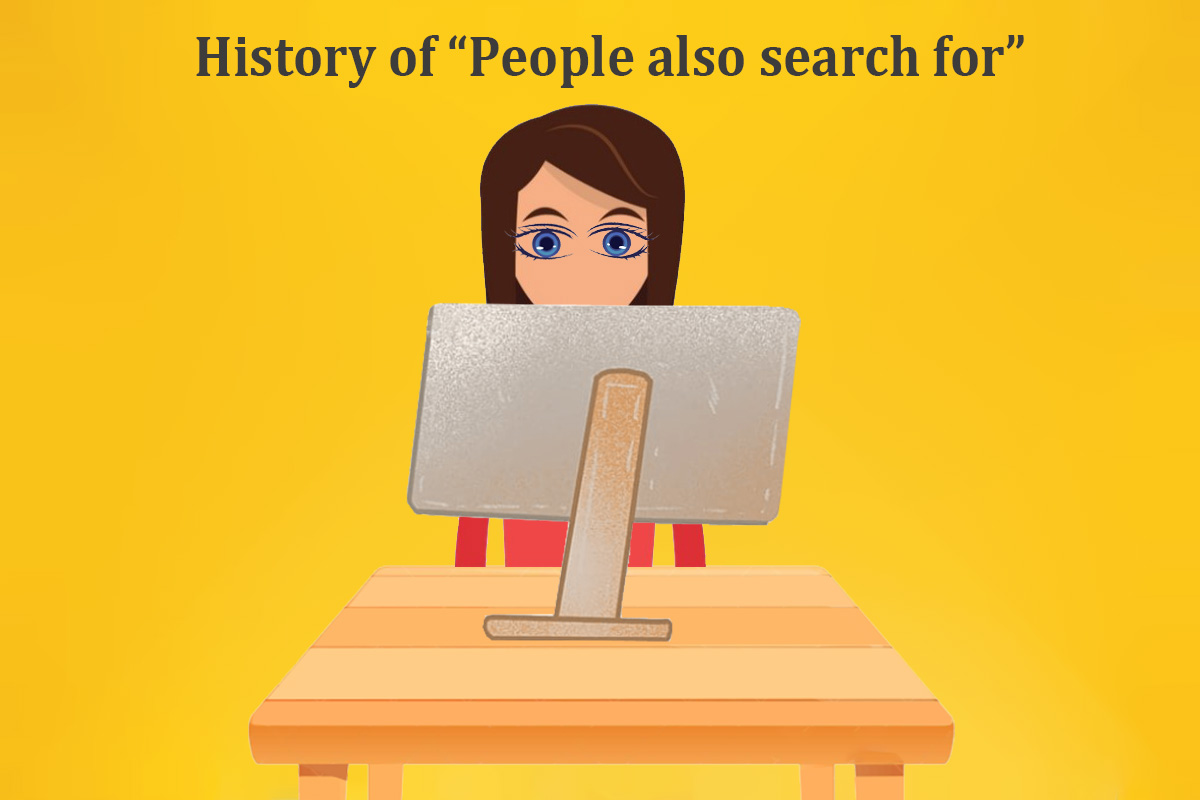History of “People Also Search For” in Google Search
Google is continuously testing numerous designs of the “People Also Search For” (PASF) feature and has been working on them in both desktop and mobile results for years.
We see more revisions and expansions as Google’s Generative AI Answer capabilities evolve. This article covers the history of this PASF feature. One thing we know for sure, there will be more tests and adaptations. This page will update as we track and report them.
Table of Contents
- History of “People Also Search For” in Google Search
- HISTORY RECAP OF “PEOPLE ALSO SEARCH FOR”
- May 2012: The Magical “People Also Search For” Feature
- June 2016: Updated “People also search for” Feature on Mobile
- February 2016: Doubling Up on PASF Answers
- September 2017: Google Displayed “People Also Search For” in Paid Results
- February 2018: Google SERPs Include New Outlined “People Also Search For” Presentation
- June 2020: Mini Organic PASF Style Changes on Mobile
- June 2021: Increased Number of PASF and Menu Filters
- July 2021: Double Column PASF on Click Back from Website
- July 2022: Google Tested Placing PASF Above PAA
- Q4 2022: Google SERPs Include Carousel “People Also Search For”
- Q1 2023: People Also Search For in the Google Knowledge Panel
- What is the Future of PASF SERPS?
- How to View Live PASF Refinements?
- How does Google Help SEOs Find What People Also Search For?
- SUMMARY: Expand Your Visibility by Gaining More Presence in PASFs
First, let’s get a basic understanding of what PASF is.
What are PASF Search Engine Results?
The search engine result page (SERP) “People Also Search For” (PASF) feature functions like a query refinement box. It displays in a box-like format that is similar to “People also ask”. Both permit searchers to click on alternative or related search queries to further refine their search results. Additionally, both show an infinite list of algorithmically generated QA responses that are related to the searcher’s query.
Users have long been able to add symbols or words to a search query to make their search results more precise. The PASF feature “thinks” for the user and attempts to help refine and speed up their search process.
When did searchers first report PASF in Google Search?
The “People also search for” SERP feature was spotted more broadly in Google SERPs during April 2015. The idea for this feature seems to stem from Google’s plan to include additional suggested query answers. It wants to save its users from excessive searching or, worse, using a competitive search engine.
Apparently, it worked well enough for the tech giant to continue to invest in this feature. The people also search for keywords box – triggered when users bounce back to the search engine result page – proved useful!
Google Search users did use the feature to refine a search when not satisfied with the initial results. As usual, for featured snippets, or if you catch a new PASF result, especially during testing, Google asks for feedback. It says, “The data you provide helps improve Google Search.”
What do PASF search engine results look like?
Google ‘People also search for’ lists may display as:
- A list of questions with short answers that display when clicked.
- A list of image results that includes text under the visual which explains the relationship between the listed image and the query.
Several image examples are included in this article to help visually explain how this rich result presents in SERPs.
HISTORY RECAP OF “PEOPLE ALSO SEARCH FOR”
From the very beginning Google designed PASF to include “facts” and answer questions searchers hadn’t thought of yet.
May 2012: The Magical “People Also Search For” Feature
The PASF Google Search feature’s origin is a journey that began in 2012 as part and parcel of the Google knowledge graphs’ announcement. It was originally intended to display image thumbnail sets akin to a specific search term. It mostly populated lists related to people, places, or things.
The May 16, 2012, Introducing the Knowledge Graph: things, not strings article by Amit Singhal, Google’s SVP of Engineering, states how this feature is rich for learning.
“We’ve always believed that the perfect search engine should understand exactly what you mean and give you back exactly what you want. And we can now sometimes help answer your next question before you’ve asked it, because the facts we show are informed by what other people have searched for. For example, the information we show for Tom Cruise answers 37 percent of next queries that people ask about him. In fact, some of the most serendipitous discoveries I’ve made using the Knowledge Graph are through the magical “People also search for” feature.” – Amit Singhal
June 2016: Updated “People also search for” Feature on Mobile
Initially spotted in June of 2016, it was temporary, the tech giant was testing for a
new PASF interface in mobile search results that was cleaner. Barry Schwartz reported that it was “more boxed-in. It also scrolls left and right, like many of the Google carousel features in mobile.”
With more of our clients’ active audiences using mobile devices, this is something we pay close attention to. Winning clicks in Google SERP real estate is important for generating visibility that can lead to revenue.
February 2016: Doubling Up on PASF Answers
Google was spotted testing double “people also search for” boxes in the search results during February 2016. The two different “People also search for” results were not side by side like some PAA boxes. While both boxes offered expansion options to gain more query responses, one was in an upper position and the other at the bottom of the results page.
This new SERP layout format means that multiple traditional organic listings drop further below or off Google’s first real estate page for the query. Only people who scroll down are likely to view the two different “People also search for” sections. It’s interesting that they feature two different sets of queries within each.
I sent feedback of a preference to view an additional result or two versus eight additional search query answers. It helps to stop and research the same query and search sequence on both mobile and desktop results simultaneously. Interestingly, it is often different.
September 2017: Google Displayed “People Also Search For” in Paid Results
The “People also search for” query refinement feature had already been around for several years in organic SERPS. But in paid results!?
In May-July of 2018, several sightings of this feature were reported in paid search results. It generated quite a discussion. Formerly discovered only in Google’s organic “People also search for” box of suggested queries, our research discovered it occurs within the paid search results after someone clicks on an ad and then returns to the search results page.
Digging deeper, we learned that the tech giant first displayed the “People also search for” suggestions in paid search results on mobile search as early as September 2017. Several paid marketing specialists shared on Twitter and in forums that they found them detracting from the ads displayed on the page. Both SEOs and SEMs could glean wording suggestions, but ad creatives gave an overall nod of disapproval.
February 2018: Google SERPs Include New Outlined “People Also Search For” Presentation
PASF results were gently highlighted to catch a searcher’s attention. By adding a box outline around ‘people also search for’ query refinements, they become more noticeable.
We first noted this SERP adjustment in February 2018 and it seemed to populate more images and video thumbnails, too.
At this time Google displayed a box around an organic query result with “people also searched for” suggestions. The box was also separated by a line to distinguish it from other search results below it. The suggestions further loaded on delay – as if the tech giant was waiting to see if we’d already clicked on a result.
They were (and still are) initially triggered when a user clicks on a result and then clicks to return to try another search result.
June 2020: Mini Organic PASF Style Changes on Mobile
It’s fascinating to see tests of different font styles, backgrounds, outlines, placements, and more. On mobile, the dark mode became more widely adopted which makes PASF stand out differently. Before we had continuous scrolling, a “People also search for” feature appeared consistently placed at the bottom of the first page on Mobile.
Brodie Clark noted: “The new aspect of this layout is the mini Organic search result which has been placed in the middle. The font size is smaller than the 10 listings above, and a description hasn’t been included (just the Title Tag and URL).” [1]
Oddly, at times, the menu filters and the section titles seemed off-track with the result. Viewers may have been confused that the overall “People also search for” display was being extracted from the Organic result. In our current tests, we no longer see this smaller font.
June 2021: Increased Number of PASF and Menu Filters
A possible test to replace some PAA with PASF.
Several marketers and SEOs reported a sharp decline in People Also Ask results. We also tested and confirmed that (at that time) Google was displaying fewer PAA on both mobile and desktop. Tools we used to confirm our finding were SE Ranking, SEMrush, and RankRanger SERP data tracking.
“Maybe more are being combined with People also search for. See the combination/mashup below. I’m seeing this across a bunch of SERPs I tested. I’m in a test where ‘People also search for’ is replaced by ‘Often searched together’. The listings look the same, so it’s Google just testing the heading. – Glenn Gabe on Twitter [2]
While exploring a particular topic On Google, searchers benefit who are unaware of one or viewpoints on the topic queried. The tech giant’s quest to be the best answer engine inspires its rapidly push forward new options.
July 2021: Double Column PASF on Click Back from Website
Our tests produced more than one column on most desktops and some mobile devices. This double-column design remains today as a box made up of related queries presenting itself after a user clicks back off a website.
At this time Google was also double efforts to make its featured snippet answers audible. There was some indication that PASF has become more accessible to users with disabilities.
July 2022: Google Tested Placing PASF Above PAA
We only found this over a brief span of time during the month of July 2022. I’m guessing Google was seeking to determine which featured snippet display gained more engagement by users.
The PASF placement and list are generated by Google’s algorithm, which takes into account a variety of factors. When Google Search and Google Bard AI blend into a new product, it’ll be interesting to see if this completely goes away or evolves somehow.
Q4 2022: Google SERPs Include Carousel “People Also Search For”
Google is adding more visual formats to its real estate. For people who use image search, this is another smart way of providing question-answer suggestions to users. This is where we see more and more lists of image results under the Google PASF real estate title.
We consider it to work like related entities. A “People Also Search For Box” may replace an Answer box or typical carousel result.
The “People Also Search For Text Box”, also known as a “People Also Search For Text Carousel” displays more often on mobile devices in our testings.
Q1 2023: People Also Search For in the Google Knowledge Panel
We’re discovering contents of the People Also Search For Box showing up in the Google Knowledge Panel more often. Any entity that accomplishes this inclusion has certainly done a lot right! These significant wins indicate that your brand has obtained credibility with Google.
Others have reported this prior to our tests. We find that Question Answering in the Google Knowledge Graph is becoming more prominent.
Such “People also search for” boxes are exclusively selected by Google algorithms for the Knowledge Panel versus the organic results (traditional blue links). No individual can directly influence its choice; however, remember that Google’s algorithms automatically select what they believe is the most helpful match.
What is the Future of PASF SERPS?
The future is sure to be exciting and no one fully knows what PASF may look like.
Google and Alphabet CEO Sundar Pichai recently stated that “every product of every company” will be impacted by the rapid progress in developing AI. Pichai further reinstated the tech giant’s commitment to resolving disinformation issues, fake news, and incorrect answers that could cause harm. [3]
By observing the patents it files, similar statements, and our SERP analysis, we believe that more ways to provide rich answer results will emerge. Today, we already see “Ask a follow up” question within Google’s Search Generative Experience.
We know that Google algorithmically selects what appears in the People Also Search For Box and then may move QA results into the Knowledge Graph. We anticipate that Google’s Magi Project will produce more ways to quickly answer users’ questions on the SERP.
Google seems to rely on a number of factors to make PASF selections and is increasingly getting better at its AI answers.
PASF displays may be triggered when your content:
- Is deemed popular in terms of search volume and engagement.
- When geographic proximity factors in.
- When the context of your content is relevant to the original search query.
- If Google deems your answers are trusted and matches the searcher’s query intent.
- Google’s understanding of your entity and what will be helpful to the user’s intent.
Very interesting – today I did a Google search for “using SaaS” on both desktop and mobile. Nothing I did would trigger a PASF. “Others want to know” is displayed where the PASF box typically shows up. Also, after I clicked on a PASF that triggered my domain, when I clicked to search again, and on a suggested link to my domain, the site link went to another domain!
We believe this is a powerful SERP feature that makes it easier and quicker for people to find the right content on the web. It’s helpful for follow-up searches when users fail to get the content they are looking for. We expect PASF, or some version of it, will continue to play a role in refining queries.
How to View Live PASF Refinements?
In order to trigger new ways Google tests the PASF feature, we take the following steps:
- Trigger a specific search result.
- Click on one of the top suggested listings.
- Return back to the same Google real estate page using the same browser.
- Repeat the same exact search query.
NOTE: This is an additional search tactic that is different from setting up FAQ texted answers in your Google Business Listing. It’s best to understand the multiple ways that you can provide direct answers to people searching for your solutions and products.
As we are dedicated to finding new ways to increase business growth for clients, Hill Web Marketing enjoys SERP QA discovery. You can learn how to use Google’s tools for FAQ research or hire us directly. We’ll continue our tests and reporting as the history of people also search for evolves.
How does Google Help SEOs Find What People Also Search For?
Your Google Search Console (GSC) reports are a gold mine of information to assist in meeting your audience’s needs that are currently unmet within your site’s content. To trigger the PASF feature, you need to first know what people search for and the keywords users are using when searching. Find insights in your GSC for content optimization that will help people find your website.
- Open your GSC and navigate to the “Performance” tab.
- Once you’re here, click on “Full report” in the upper right-hand corner.
- Next, click on your “QUERIES” tab.
- Identify QA queries that you have many impressions for but few clicks.
We’ve dedicated an in-depth article on how to find question-answer content gaps that are rich with opportunity. While we recommend starting with how Google sees you, there are additional process and tools you can use.
The PASF feature is now a valuable tool for both users and webmasters. For users, PASF can help them find more information about the topics they are interested in. For webmasters, PASF can help them identify new opportunities to attract traffic to their websites.
Google continually updates and tests PASF. This stresses Google’s dedication to surfacing good quality content and a better overall user experience whilst users utilize its search engine. If you have other PASF findings or comments, we welcome them below or on Twitter where we often converse on this and related SERP topics.
SUMMARY: Expand Your Visibility by Gaining More Presence in PASFs
Ideally, you may want to show up first in a PAA box or “Relates searches”. The same focus on building your E-E-A-T applies. The difference may lie more in how clear the searcher’s original query is.
The “People also search for” box offers multiple unique insights into the buyer’s journey. It is a rich resource for understanding how to leverage the information it provides so your business entity can become the go-to source for trusted answers and solutions. If you’re struggling to keep up with search changes or are ready to improve your site’s content – call 651.206.2410.
Take your place on the SERP! Move forward today and Request Your Own SERP Analysis
References
[1] https://brodieclark.com/people-also-search-for-test/
[2] https://twitter.com/glenngabe/status/1406601750921072643
[3] https://www.cnbc.com/2023/04/17/google-ceo-sundar-pichai-warns-society-to-brace-for-impact-of-ai-acceleration.html
